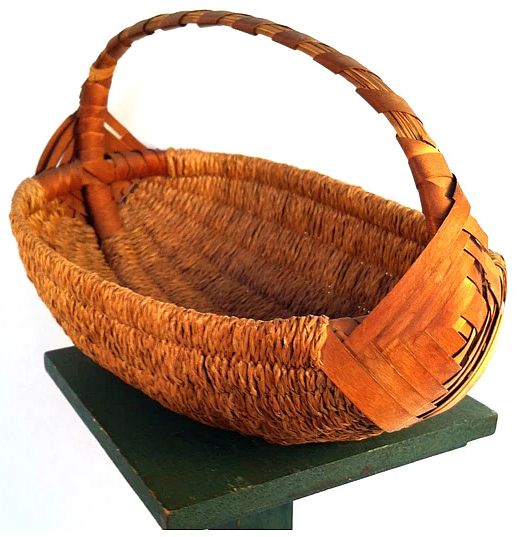
Maine’s Most Amazing Art

It is only natural that the people who first lived in this beautiful state, who left a legacy of respect for the waters and the woods, the lowlands and the heights, the inlands and the coast and who were caring about the bounty of nature would also develop a tradition of artwork that is legendary: basketmaking.
Basketmaking is not only the oldest form of art, it fills purposes both utilitarian and decorative and has a vibrant history in Maine where the Wabanaki Indian tribes — the Penobscot, the Passamaquoddy, the Maliseets and the Micmacs — have perfected the art.
While work baskets, used for gathering, storing and transporting primarily food date back more than 400 years, it is the production of the decorative — the fancy — basket, which began in the late 1880s that has formed the core of a world class collection that will be the feature presenta- tion at the August 15 meeting of the Belgrade Historical Society by collectors Larry and Debbie Onie.
The Onie’s connection to Maine is a not unusual introduction. They were staying at the Great Pond Campground one very rainy day in 1978 and decided to visit Belgrade Lakes Village to escape the rain, walked into a local real estate office, and were shown a camp that they fell in love with. Their story became unique when they decided to decorate with a few traditional Maine Indian baskets and than a few more…The story is now a legend when 45 years later they have a collection of hundreds of Wabanaki fancy baskets.
“We had no intention to become collectors,” Larry describes. “Deb always decorated our home in Brookline, Massachusetts with antiques and wanted to do the same for our camp. We got everything one-by-one.”
In the collecting, they discovered much of the history of the Wabanaki basketmaking. Most of the artists were women. They gathered sweet grass from the coast, a labor intensive and prickly endeavor. They took splints from the black ash trees the men cut down in the swamps. They created all their forms, which include at least 50 styles. And, they painstakingly wove, added color and decorative designs, all passed down from women to women.
Although baskets were not signed until the 1980s, the couple extensively researched much of the early fancy baskets. Later they developed a relationship with today’s artists. Today, they are considered stewards of the heritage. One of the great things about the journey Deb and he have been on, Larry points out, is the transcultural exchange between Indians and non-Indians.
To date the Onie’s collection has been featured in Martha Stewart Living, Native Peoples Magazine, and Country Living. It was recently part of the Tender Loving Care Exhibit at the Boston Museum of Fine Arts and is currently part of the Wabnaki Exhibit at the Skowhegan History House, 66 Elm Street, Skowhegan, which is open 10 a.m. – 4 p.m. Tuesday through Friday.
The collection has also been highly documented by historians and has been highlighted by historical societies, such as the Belgrade Historical Society. Everyone is invited to view the impressive range and scope of the Wabanaki fancy basket col- lection at www.wabanakifancybaskets.com.
Download Full Newspaper: High Res | Low Res (Details…)
<— Summaries • Next Article —>
©2023 by Summertime in the Belgrades. All rights reserved.